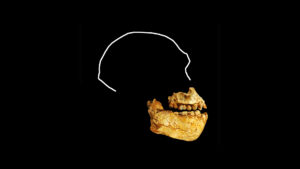
Image credit Yohannes Haile-Selassie
Australopithecus deyiremeda is a hominin species that was named in 2015 based on upper and lower jaw fossils recovered from the Woranso-Mille area of the Afar region of Ethiopia. The holotype (type specimen) of Au. deyiremeda is an upper jaw with teeth. The paratypes are two lower jaws and a small fragment of the upper jaw. Au. deyiremeda lived alongside the famous Lucy’s species (Australopithecus afarensis), which lived from 3.8 million years ago to 2.95 million years ago, overlapping in time with Au. deyiremeda. The age of Au. deyiremeda is very well constrained by the regional geology, radiometric dating, and paleomagnetic data. The combined evidence from radiometric, paleomagnetic, and depositional rate analyses yields estimated minimum and maximum ages of 3.3 and 3.5 million years.
The species name “deyiremeda” (day-ihreme-dah) means “close relative” in the language spoken by the Afar people. Australopithecus deyiremeda is distinguished from the contemporaneous Au. afarensis by the shape and size of its thick-enameled teeth, more anteriorly positioned origin of the cheek bones, and the robust architecture of its lower jaws. The anterior teeth are also relatively small indicating that it probably had a different diet. However, some paleoanthropologists have argued that the specimens assigned to Au. deyiremeda could be subsumed within the morphological range of variation in Au. afarensis and hence should be included into that species. Historically, paleoanthropologists have long argued that there was only Au. afarensis between 3.8 and 3.0 million years ago, which subsequently gave rise to other species after three million years ago. This was what the fossil record appeared to indicate until the early 1990s. However, the naming of Australopithecus bahrelghazali from Chad and Kenyanthropus platyops from Kenya, both from the same time period as Lucy’s species, challenged this long-held idea. Although a number of researchers were also skeptical about the validity of these species, the discovery of the 3.4-million-year-old Burtele partial foot in 2012 cleared some of the skepticism on the likelihood of multiple early hominin species in the 3.0- to 4.0-million-year range because the Burtele partial fossil foot, with an opposable big toe, did not belong to a member of Lucy’s species.
Au.deyiremeda provided further evidence that Au. afarensis was not the only potential human ancestor species that roamed in what is now the Afar region of Ethiopia during the middle Pliocene. Au. deyiremeda also raised significant ecological questions, such as how multiple early hominins living at the same time and geographic area might have used the shared landscape and available resources.